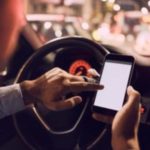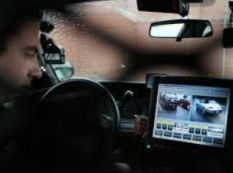Blog
Can Telematics Technology Prevent Distracted Driving Created by Technology?
Originally published in Fleet Management Weekly 4/5/23
By Dr. Paul Atchley, eDriving’s Brain Scientist/Advisor
In 2019, I authored an article in this publication titled “Fleet Safety: It is You versus Silicon Valley.” In that article, I discussed how phones and apps are designed to promote user engagement and how that poses a risk to fleet safety. It was pitched as a battle between a cell phone-addicted driver population and fleet managers trying to keep those drivers and the driving public safe from the crashes associated with distracted driving.
That story has not changed, except, perhaps, for the worse. Crash data from the period of the pandemic shocked everyone. As the National Safety Council (NSC) reported in 2021, ‘a 24% spike in roadway death rates is the highest in 96 years’, despite decreases in miles driven. The data show we are still going in the wrong direction. In late 2022 the NSC reported ‘Traffic is Back to Pre-pandemic Levels, Deaths Continue to Climb.’ Is there reason to believe phones are responsible? The answer is unequivocally “Yes.”
 Telematics company Zendrive has chronicled the increase in phone use while driving in its data-reports going back to 2017. Their data show alarmingly high rates of phone and app use. For example, in 2017, they reported 88% of trips involved phone use. The frequency of phone use and the number of apps used during a trip has continued to increase. Analyzing data from over 86,000 collisions during the 2020 crash spike NSC raised alarms about, Zendrive found 57% of crashes involved phone use before the impact, with about 17% of crashes involving phone use in the 5 seconds before the crash.
Telematics company Zendrive has chronicled the increase in phone use while driving in its data-reports going back to 2017. Their data show alarmingly high rates of phone and app use. For example, in 2017, they reported 88% of trips involved phone use. The frequency of phone use and the number of apps used during a trip has continued to increase. Analyzing data from over 86,000 collisions during the 2020 crash spike NSC raised alarms about, Zendrive found 57% of crashes involved phone use before the impact, with about 17% of crashes involving phone use in the 5 seconds before the crash.
What is a fleet manager to do? Science shows phones compel use, and that leads to increased crash risk. On-road data show increased phone use and increased phone involvement in crashes, matching the science. Drivers want their phones, but the phones make driving dangerous. Fortunately, the science of human behavior can tell us how to solve this problem, and on-road studies from fleet organizations and telematics companies show us how driver safety can be improved.
The science of human behavior tells us that change starts with an understanding of the rules. Safety rules are critical, and communication that safety is the expected social norm in an organization is key. This means leaders must set clear expectations for distracted driving and the rules must be clear. As the NSC says in its cell phone policy toolkit, a policy must cover all employees and it must be comprehensive.
 Science also tells us that the most powerful tool for behavior change is observing and recording the behavior and pairing those measurements with some outcome. And this is where technology (paired with leadership, rules, and human intervention) can help us solve the problems that technology has created. Driving telematics make observing and making a record of driving behaviors possible. When those data are paired with leadership expectations biased toward fleet safety, rules to promote safe driving, and mechanisms of enforcement for those rules, safety happens.
Science also tells us that the most powerful tool for behavior change is observing and recording the behavior and pairing those measurements with some outcome. And this is where technology (paired with leadership, rules, and human intervention) can help us solve the problems that technology has created. Driving telematics make observing and making a record of driving behaviors possible. When those data are paired with leadership expectations biased toward fleet safety, rules to promote safe driving, and mechanisms of enforcement for those rules, safety happens.
Driver risk management provider eDriving has some excellent data showing how this works in practice. eDriving has a phone-based telematics solution, Mentor, which provides data on driving performance for each employee. Using sensors and data from the phone, Mentor can assess key performance indicators such as hard acceleration, braking and cornering, (and their positive, or smooth, equivalents), speeding and various aspects of phone-based distractions. The company teamed with the data wizards at Fair Isaac Company (FICO) to create an aggregate FICO® Safe Driving Score proven to predict the likelihood of a driver being involved in a crash.
Employees and managers can use these data to understand the overall risk level of an employee or group within an organization. This provides a powerful observational tool, consistent with the science of behavior change. So, how are these data used? When leadership sets an expectation of safety and rules that promote safe driving, the observations lead to outcomes. Mentor employs a multi-faceted suite of such outcomes or interventions to address risky behavior. These include eLearning, gamification, rewards, and coaching for drivers that are not “making the grade” when it comes to safety. One Mentor customer, Ecolab, realized a 37% reduction in crashes per million miles when they paired telematics with coaching for their “at-risk” drivers.
 A subsequent study by eDriving published this year confirms the benefit of observation with interventions. Looking back at 3.5 billion miles of observed driving by Spring of 2022, eDriving found that drivers assessed to be in the highest categories of risk showed marked improvements when those data are paired with the full suite of interventions and support. The negative behaviors decreased by over half at six months and by almost 90% at 18 months, and the positive behaviors (smooth acceleration, braking and cornering) increased. Specifically, phone manipulation events logged by Mentor drivers decreased by 62% at six months and by 89% at 18 months.
A subsequent study by eDriving published this year confirms the benefit of observation with interventions. Looking back at 3.5 billion miles of observed driving by Spring of 2022, eDriving found that drivers assessed to be in the highest categories of risk showed marked improvements when those data are paired with the full suite of interventions and support. The negative behaviors decreased by over half at six months and by almost 90% at 18 months, and the positive behaviors (smooth acceleration, braking and cornering) increased. Specifically, phone manipulation events logged by Mentor drivers decreased by 62% at six months and by 89% at 18 months.
So, when it comes to technology, we must remind ourselves that technology is a tool of our making. It is neither good nor bad without the human hand to direct it. In the case of crash risk, technology can pose a threat, or it can offer a way to improve our safety. But these outcomes require us to make them real. In the absence of human intervention, phones will continue to make our roads less safe. But with leadership, rules, technology-enabled observation, and intervention, we can reverse that trend. The choice is in your hands.
About the author
 eDriving’s Brain Scientist/Advisor and Professor of Psychology at the University of South Florida, Dr. Paul Atchley has been conducting research and teaching about cognitive factors related to driving for over 30 years. He specializes in research on the real-world implications of multitasking, and addresses distracted driving from multiple perspectives, working to communicate this expertise publicly so that it can accelerate positive change.
eDriving’s Brain Scientist/Advisor and Professor of Psychology at the University of South Florida, Dr. Paul Atchley has been conducting research and teaching about cognitive factors related to driving for over 30 years. He specializes in research on the real-world implications of multitasking, and addresses distracted driving from multiple perspectives, working to communicate this expertise publicly so that it can accelerate positive change.